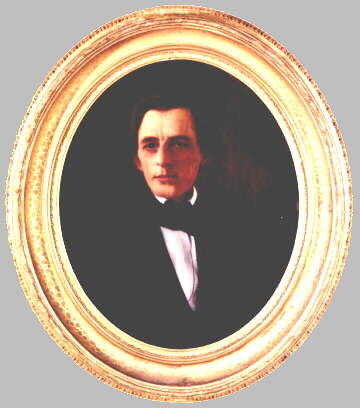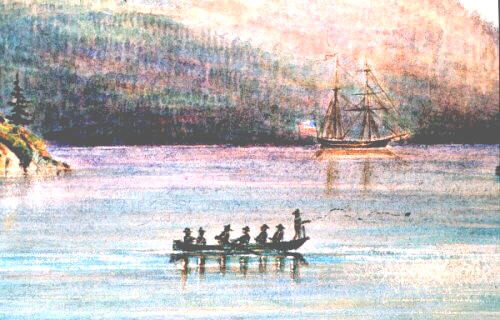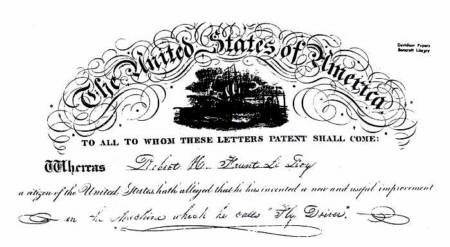Robert Henry Fauntleroy (1806-1849)
civil engineer
In 1827, Robert Henry Fauntleroy moved from Virginia to New Harmony, Indiana. There he married Jane Dale Owen, one of the five children of social reformer Robert Owen, who had purchased the town in 1825. As an engineer, Fauntleroy was awarded patents for two inventions. He was an Assistant in the U. S. Coast Survey, reporting directly to the Superintendent, at the time of his death.
The name Fauntleroy is well known in modern New Harmony, and The Old Fauntleroy Home is visited by hundreds tourists each year. The home has been associated with several members of the Fauntleroy family, beginning with Robert Henry Fauntleroy, who bought the home from Oliver Evans, Jr., in 1840.
|
 |
| Portrait of Robert Henry Fauntleroy in the Old Fauntleroy Home,
New Harmony, Indiana, by permission of the Indiana Department of
Natural Resources, copyright © Indiana State Museum and Historic Sites. Based on a daguerrotype; artist unknown. |
Unfortunately, some New Harmony histories have given misleading genealogical accounts. These can be corrected by reference to The Fauntleroy Family, privately published by Robert Harrison Fauntleroy in 1952.
Joseph Fauntleroy, son of Griffin Murdock Fauntleroy and Anne Belfield, was born in 1784 and died in 1832. He inherited from his father the 500 acre plantation in Richmond County [Virginia] called "Mars Hill" in 1794, and in 1810 he sold it to Peter Northen, and moved to Clarke Co. [then Frederick Co.]. In 1811 he married his first cousin, Emily Carter Fauntleroy, daughter of Joseph Fauntleroy and Elizabeth Fouchee Fauntleroy, of "Greenville," Clarke County. In 1827 he sold his property in Clarke County, freed his slaves, and went to New Harmony, Indiana... He took with him his wife and their eight children and two of his freed Negro slaves, and they were accompanied by four of Emily Carter Fauntleroy's brothers, [including] Robert Henry Fauntleroy.
Robert Henry Fauntleroy was born in 1806 at Greenville, the son of Joseph Fauntleroy (1754-1815) and his cousin, Elizabeth Fouchee Fauntleroy (1772-1824). His father (son of William Fauntleroy and Margaret Murcock) was a different Joseph from the one who moved to New Harmony. The first Greenville dwelling was built in 1795 by Robert's father. At present, on or near the site of the Greenville house is a later historic house called Red Gate: "Today the lovely painted white brick home is nestled in old boxwoods and has an expanisve panorama of the Blue Ridge Mountains and Clarke County farmland." - from Annals of Clarke County, Virginia, v. 1, by Stuart E. Brown, Jr., 1983.
The wedding of Robert Henry Fauntleroy and Jane Dale Owen, on March 23, 1835, can be compared to that Robert Dale Owen, Jane's older brother. Both weddings took place at home in New Harmony and were not registered in official Posey County records. The earlier wedding has been described elsewhere, and R. D. Owen's
defiant statement on his wedding day perhaps speaks also for his sister's wedding three years later. (A note written by Ellinor Fauntleroy Davidson, in the Davidson Papers, Bancroft Library, University of California, Berkeley, may be the only record of the location of her parents' wedding as New Harmony.)
To this marriage were born four children: Edward, Albert, Constance, and Ellinor. It was for them that an unpublished account of their father's life and work was written by their mother: Records of a Beloved Life, For My Children. A typescript bearing Albert's initials, preserved in the previously mentioned Davidson Papers, describes Robert's work in 1835-1837 leading to his appointment as "Resident Engineer on a line of macadamized road, called the Jeffersonville & Crawfordsville Road, at a yearly salary of $1500." This and other large scale federally funded and state funded projects were short-lived, and Fauntleroy eventually joined James Sampson in a mercantile business, Sampson & Fauntleroy, in New Harmony. This partnership lasted three years.
In 1846, Fauntleroy began work for the U. S. Coast Survey, largely along the Gulf of Mexico. During the next three years, one of his younger co-workers, George Davidson, returned with him to New Harmony.
Fauntleroy's influence on Davidson was great, and after the former's death, Davidson, who became the principal surveyor of the American west coast, commemorated his mentor by naming a Coast Survey brig in his honor. (For details, click on Davidsons's name at the end of this page.)
|

|
|
Charting party off USCS Brig Fauntleroy, watercolor by James Madison Alden, 1857, in Burke Museum of the University of Washington. Used by permission of NOAA Photo Library.
|
In her "Records of a Beloved Life," Jane Dale Fauntleroy wrote that her husband
took out two Patents; one for an improvement in gun-locks, termed the "relief lock." Next for a "fly-drive" for the use of the sick in summer...
He became very expert in mechanical drawing... An immense number of drawings embracing all kinds of Civil Engineering and Mill Work, are among your Father's papers. He particularly directed his attention at one time to the study of Undershot and Overshot Wheels and investigated thoroughly the intricacies of cotton as well as grist mills [and Steam engine and "Strength and Stress of Materials"]...
When employed as Engineer by the State of Indiana, he invented his "Elliptograph" [and] "Cross Level"... [A drawing of the former is preserved in the New Harmony Workingmen's Institute.]
One of your Father's last acts before he left on his fatal journey was to write a description of an invention which he called a "Self-registering Log" for the use of vessels & forward it to Commodore Skinner at Washington, for his opinion of its nautical value. [The reference is to Captain Charles William Skinner, Chief of the Bureau of Construction and Repair (of the United States Navy), 1847-1852.]
|
The two patents mentioned by Jane Fauntleroy are signed by Andrew Jackson, President of the United States. The patent for a gun lock is dated August 17, 1833, and that for the fly driver is dated August 13, 1834.
|

|
|
Top of the 1834 patent, Davidson Papers, Bancroft Library, University of California, Berkeley
|
|
A document accompanying the 1833 patent describes the invention as an attachment to the gun lock so as "to render it unnecessary for the person...to set the trigger stile...previous to cocking the gun, as said trigger is set by the lock itself and thus guards against the loss of time in expert shooting and the forgetfulness of the huntsman in making ready to shoot."
|

|
|
President Jackson's signature on the 1834 patent; Bancroft Library
|
Among the documents reposing in the Davidson Papers is a formal Correspondence from A. D. Bache, Superintendent U. S. Coast Survey to Hon W. M. Meredith, Secretary of the Treasury, dated January 14, 1850:
SIR: - It is my painful duty to announce to the Department the death of Assistant R. H. Fauntleroy, of the Coast Survey, which occurred in Galveston, Texas, on the 13th ult., and has been officially communicated to me by sub-Assistant S. A. Gilbert.
Mr. Fauntleroy was appointed an Assistant in the Coast Survey in 1846 and has served most zealously and successfully in Sections VIII and IX of the work. His attainments as a mathematician and astronomer, and in geodsy were of a high order. His patient and conscientious disposition made him most valuable as an observer. As a chief of a party he had the esteem of all his subordinates, and the warm affection of those immediately in contact with him. As an Assistant he was invaluable. His labors on the coast of Alabama, Mississippi and Texas have been very arduous, but I had no idea of the extent to which his health appears to have been impaired by them, so as to give way to the first attack. He reached Galveston after a very stormy passage from New Orleans, on the 12th of December, was attacked the same night with Cholera, and died after an illness of thirteen hours.
The loss of this able and estimable man will be deeply deplored by all the officers of the Coast Survey.
His service will be most sensibly missed upon the work to which he had devoted his best energies and remarkable talents.
Mr. Fauntleroy was under instructions to proceed with the triangulation of the coast of Texas which he had already commenced, and on learning his lamented decease I instructed, under authority of the General Directions for the year, Assistant R. D. Cutts, of the Coast Survey, to proceed as early as possible to Galveston and to organize a triangulation party for proceeding with the Survey there.
Robert Henry Fauntleroy published an article in one of the foremost American scientific journals of his time. Entitled "On the Conditition of Equilibrium between Living and Dead Forces," it is found in Vol. 47 of the American Journal of Science (sometimes called Silliman's Journal in reference to its founder, Benjamin Silliman, of Yale University), dated July-Sept., 1844. At that time, the terms living forces and dead forces were commonly used for forces now studied in statics and dynamics. Fauntleroy's introductory paragraph follows:
It is of essential importance to practical mechanics to establish mathematically the relations between a moving or living force and a pressure or weight at rest, sometimes called a dead force. As for example, it is frequently important to know the greatest weight which may be placed on the head of a pile without causing it to sink deeper, the circumstances attending the driving being know. It is chiefly to facilitate the solution of problems of this nature that the following remarks are submitted.
Fauntleroy then derives equations for the displacement of an object when struck by another. The equations are supported by experimental results:
... the writer has roughly tested [equations labeled A, B, C, and D] by experiments made with small battens of yellow poplar weighing one pound and under, clamped between boards and driven by small weights of the same material varying from a quarter to two points, falling heights from one to four feet, and driving the battens from [0.16 to 1.25] inches at a blow...
... If the foregoing remarks should stimulate inquiry on the part of others better qualified than the writer, to a degree at all proportioned to the importance of the subject, his highest aim will be gratified.
Jane Dale Owen Fauntleroy
George Davidson
New Harmony Scientists, Educators, Writers & Artists
Clark Kimberling Home Page



